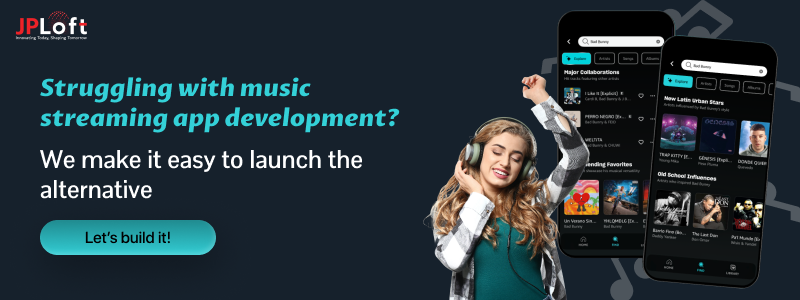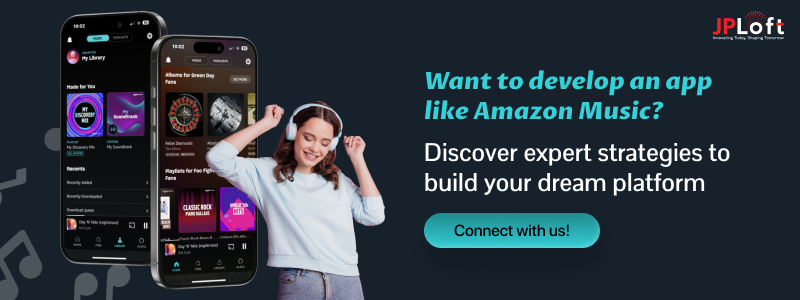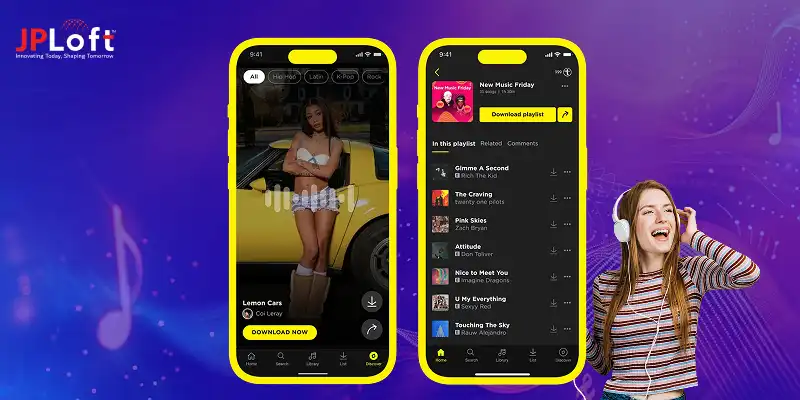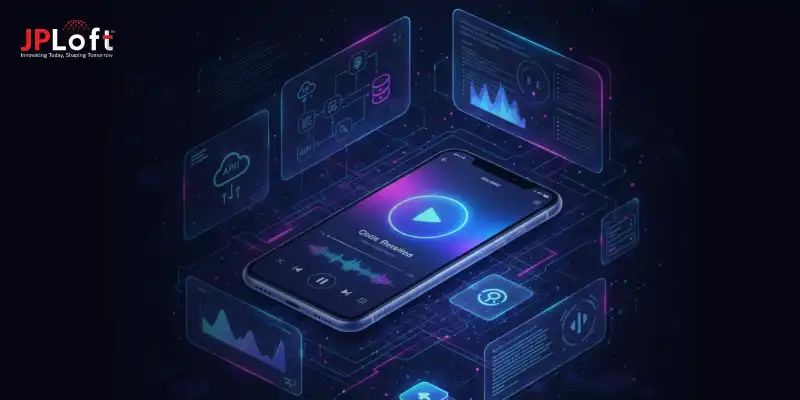Are you a true music lover, and Amazon Music has become your go-to app for every mood? Then at some point, you must have wondered: “How to Develop an App like Amazon Music?” The answer is simple, it takes market research, a good design, and the right tech stack.
In 2025, building a music streaming app isn’t just about songs, it’s about creating an immersive experience with personalized playlists, offline access, and seamless multi-device syncing.
If you’re ready to build an app like Amazon Music, this blog will walk you through its core features, cost factors, future opportunities, and exact steps to turn your vision into a powerful streaming platform that resonates with millions of listeners.
Let’s go into the depths of the development journey.
Key Takeaways
A global music streaming platform offering millions of songs, podcasts, and AI-powered personalized experiences, inspiring entrepreneurs to create an app like Amazon Music.
Offline listening, AI recommendations, multi-device syncing, HD audio, playlists, and social sharing are essential features for engagement.
Building a successful and custom app like Amazon Music starts with market research to backend, licensing, testing, and launch.
Building an app like Amazon Music ranges from $30,000 to $150,000 depending on features and complexity.
Subscription, ads, in-app purchases, partnerships, and hybrid strategies generate multiple revenue streams.
JPLoft builds scalable, secure, and innovative music streaming apps with AI-powered personalization and advanced features.
What is the Amazon Music App?
If you are planning to build a music streaming app, the first question that comes to mind is: “What is the Amazon Music App and how does it exactly work?” Isn’t it?
Well, Amazon Music is one of the world’s most loved and widely used music streaming platforms, trusted by millions of users globally. It offers a massive library of songs, podcasts, curated playlists, and even live content, all accessible with just a few taps.
What sets Amazon Music apart from other streaming platforms is its seamless integration with Alexa, allowing users to play music hands-free through voice commands.
It also provides personalized recommendations powered by AI, offline listening for on-the-go convenience, and HD and Ultra HD sound quality for audiophiles who don’t want to compromise on experience.
From a functionality perspective, the app allows users to browse, stream, and download tracks, manage playlists, and enjoy cross-device syncing, ensuring smooth playback whether you’re using a smartphone, tablet, smart speaker, or car infotainment system.
Why Build an App Like Amazon Music?
Thinking about whether it’s worth stepping into the music streaming industry? Here’s why businesses and entrepreneurs are choosing to develop an app like Amazon Music:
-
Massive Audience Demand: Music is universal, and millions of users are actively searching for better streaming experiences. This makes it the perfect time to explore new music app ideas and create an app like Amazon Music to capture a growing audience.
-
Growing Market Size: The global music streaming market is booming, with revenues expected to climb steadily in 2025 and beyond. For anyone looking to make an app like Amazon Music, the industry offers enormous potential to scale.
-
Brand Loyalty & Engagement: Unlike many apps that people open occasionally, music apps are used daily. With playlists, podcasts, and personalized recommendations, you can foster strong connections and long-term loyalty when you make a custom music streaming app like Amazon Music.
-
Monetization Opportunities: Subscriptions, in-app purchases, ads, and premium features create multiple revenue streams. This ensures that when you start a music streaming business, you’re not just building an app, you’re creating a profitable ecosystem.
-
Tech-Driven Future: With AI, voice assistants, and smart devices, there’s endless scope to innovate and deliver unique experiences when you develop an app like Amazon Music.
In short, the music streaming industry isn’t just growing, it’s thriving. If you want to tap into a fast-expanding market and build a product that people use daily, now is the best time to enter the industry.
Key Features of a Music Streaming App Like Amazon Music
When it comes to building a successful music app, “features” are the real game-changers. Think about it, would you use a music app that’s slow, lacks personalization, or doesn’t let you download songs? Probably not.
That’s why, if you want to make a music streaming app like Amazon Music, adding the right set of functionalities is a must. These top music app features not only enhance user experience but also help your app stand out in the highly competitive streaming market.
Here’s a quick breakdown of the must-have features:
|
Feature |
Description |
|
User Registration & Profiles |
Easy sign-up with email, social media, or phone number, allowing users to create personalized profiles. |
|
Vast Music Library |
Millions of songs, albums, and podcasts available with advanced filtering and browsing options. |
|
Search & Smart Recommendations |
AI-powered search and personalized playlists based on user preferences and listening history. |
|
Offline Listening |
Download and listen to tracks anytime, anywhere without internet access. |
|
Multi-Device Syncing |
Seamless music streaming across smartphones, tablets, smart speakers, and even car systems. |
|
High-Quality Audio |
Options for HD and Ultra HD sound for users who want premium audio experiences. |
|
Voice Assistant Integration |
Hands-free controls through Alexa, Google Assistant, or Siri for a modern listening experience. |
|
In-App Purchases & Subscriptions |
Multiple monetization models including free, premium, and family plans. |
|
Playlist Management |
Ability to create, share, and customize playlists, making music more personal. |
|
Social Sharing |
Users can share songs, albums, or playlists on social media to increase engagement. |
At the end of the day, these top features are what separate a basic streaming app from one that users truly love. If you integrate them smartly, your app won’t just compete; it will set new benchmarks in the music streaming industry.
How to Develop an App Like Amazon Music: Step-by-Step Process
Every successful app starts with a roadmap. And you might be asking yourself, “How to build an app like Amazon Music with proper steps?" The answer lies in following a structured step-by-step process that transforms your idea into a fully functional music streaming app.
It’s about blending technology, design, and user experience into one powerful package. Here is the complete process to develop an app like Amazon Music.
Quick Steps to Create an App Like Amazon Music
Before diving deep, here’s a snapshot of the major steps:
-
Market Research & Competitor Analysis
-
Define Core Features & Tech Stack
-
UI/UX Design & Wireframing
-
Backend Development & APIs
-
Licensing & Music Content Integration
-
AI-Powered Personalization
-
Testing & Quality Assurance
-
Launch & Marketing Strategy
-
Ongoing Music App Maintenance & Security
Now, let’s explore each step in detail to understand the steps to create a music streaming app like Amazon Music.
Step 1: Market Research & Competitor Analysis
The first step to develop an app like Amazon Music is understanding the market. You need to study your target audience, what genres they prefer, how they consume music, and which devices they use most.
Also, analyze competitors like Spotify, Apple Music, and even emerging apps. For instance, when you aim to develop an app like Spotify, you can learn how their personalization algorithm keeps users engaged.
Proper research will help you identify gaps and come up with innovative apps ideas that can make your product stand out among the top apps.
Step 2: Define Core Features & Tech Stack
Once the research is done, it’s time to finalize the features. From offline downloads to AI-driven playlists, each functionality should improve the user experience. At this stage, you also choose the right tech stack, programming languages, frameworks, and cloud solutions.
If your vision is to make a custom music streaming app like Amazon Music, your features must include personalization, social sharing, and robust search capabilities. These features not only attract users but also ensure long-term engagement.
Step 3: UI/UX Design & Wireframing
A music app must feel intuitive and visually appealing. The goal is to design an app that users enjoy navigating daily. App wireframing helps visualize the overall flow, while app prototyping allows you to test usability and interactions before development begins.
When you create an app like Amazon Music, focus on smooth navigation, attractive playlists, and easy discovery. Remember, even if your app has great music, poor design can push users away.
Step 4: Backend Development & APIs
The backbone of Amazon Music-like app development is the backend. You’ll need secure databases, servers, and APIs to manage millions of tracks, user accounts, and real-time streaming. Cloud solutions like AWS or Google Cloud are commonly used.
If you aim to build an app like Amazon Music, ensure your backend is scalable to handle traffic spikes during peak usage. This is also where music app security becomes critical, protecting user data, payments, and content rights.
Step 5: Licensing & Music Content Integration
No music app can survive without legal content. To make a music streaming app like Amazon Music, you must secure proper licenses from record labels and music publishers. There are mainly two types:
-
Sound Recording License: For playing actual recordings.
-
Musical Composition License: For lyrics and compositions.
Without proper licensing, even the most advanced music sharing app development like Amazon Music will fail legally.
Step 6: AI-Powered Personalization
One of the biggest reasons people love Amazon Music is personalization. AI algorithms track listening history, mood, and preferences to suggest playlists. If you’re thinking about AI in music apps, this is where it adds massive value.
When you create an app like Amazon Music, integrating AI ensures that your users always feel like the app understands them, making it addictive and engaging.
Step 7: Testing & Quality Assurance
Before launching, your app must go through multiple app testing stages, functionality, usability, performance, and security. Testing ensures that your app works seamlessly across devices and platforms.
For example, if you also plan to develop an app like Amazon Music you’ll notice how streaming apps undergo rigorous testing to prevent glitches during high traffic. Thorough QA not only improves user satisfaction but also builds trust and credibility.
Step 8: Launch & Marketing Strategy
Once your app is ready, the next step is launching it to the world. A smart marketing strategy, social media buzz, influencer tie-ups, and pre-launch campaigns, can help you gain traction.
To go live, you’ll need to submit an iOS app to the App Store, following Apple’s guidelines.If you aim to build an app like Amazon Music, branding is as important as development.
Finally, don’t forget to publish an app to Google Play Store to reach a wider audience and maximize downloads.
Step 9: Ongoing Maintenance & Security
The journey doesn’t end with the launch. To keep your app running smoothly, you need regular updates, bug fixes, and security patches. Music app maintenance ensures your users stay satisfied, while robust app security keeps their data protected.
Over time, you can also enhance features to create immersive experiences that redefine how users interact with music. Imagine virtual concerts, 3D audio effects, or even AR-based karaoke features.
So, it’s the complete process to develop an app like Amazon Music. From market research to launch and beyond, every step matters.
The key is to blend innovation, technology, and user-centric design. If you follow these steps, you’ll not only build a competitive product but also carve your place in the booming music streaming industry.
Tech Stack for Developing an App Like Amazon Music
When you decide to develop an app like Amazon Music, choosing the right tech stack is one of the most crucial steps. It’s the foundation that powers everything, streaming quality, app speed, and scalability.
If you want to build a music streaming app like Amazon Music that competes with global players, your tools and frameworks must be reliable and future-ready.
Below is a breakdown of the essential technologies you’ll need for development:
|
Category |
Technologies / Tools |
Why It’s Important |
|
Frontend (App Interface) |
React Native, Flutter, Swift (iOS), Kotlin (Android) |
Ensures smooth, cross-platform performance with intuitive UI. |
|
Backend (Server-Side) |
Node.js, Django, Ruby on Rails |
Handles user data, music libraries, and real-time streaming. |
|
Database |
PostgreSQL, MySQL, MongoDB |
Stores user profiles, playlists, and track metadata securely. |
|
Cloud Storage & Hosting |
AWS, Google Cloud, Microsoft Azure |
Provides scalable storage for millions of songs and high-speed streaming. |
|
Music Streaming APIs |
Spotify SDK, Apple Music API, Custom APIs |
Allows integration of music catalogs, metadata, and playback controls. |
|
AI & Personalization |
TensorFlow, Scikit-learn, Amazon SageMaker |
Delivers smart recommendations and personalized playlists. |
|
Payment Gateways |
Stripe, PayPal, Razorpay |
Enables smooth in-app purchases and subscriptions. |
|
Security |
SSL Encryption, OAuth 2.0, JWT |
Strengthens security and protects user data. |
|
Testing Tools |
Selenium, Appium, JUnit |
Ensures quality, performance, and bug-free launch. |
|
Deployment |
Docker, Kubernetes |
Makes the app scalable and easy to maintain post-launch. |
With this tech stack, you can make a custom music streaming app like Amazon Music that is robust, secure, and scalable. Also, to avoid the common reasons why music apps fail, it’s crucial to combine strong backend performance with innovative experiences.
This not only enhances user engagement but also prepares your app for the future of immersive entertainment.
Cost to Develop an App Like Amazon Music
One of the first questions that comes to mind when planning Amazon Music-like app development is: “What is the real music streaming app development cost, and how much budget should I allocate?”
The truth is, there’s no one-size-fits-all answer, because the cost depends on multiple factors like app complexity, features, tech stack, team size, and even the region where you hire developers.
On average, the cost to develop an app like Amazon Music ranges between $30,000 to $150,000, making it an investment that needs careful planning.
A simple MVP (Minimum Viable Product) with basic features like streaming, playlists, and user accounts will cost less, while a fully-featured solution with AI recommendations, voice assistant integration, and offline downloads can fall on the higher end of the spectrum.
Below is a cost breakdown to understand better the cost to build an app of different development stages:
|
Development Stage |
Estimated Cost (USD) |
Details |
|
Market Research & Planning |
$3,000 – $8,000 |
Understanding user needs, competitor analysis, and app roadmap. |
|
UI/UX Design |
$5,000 – $15,000 |
Wireframes, prototyping, and engaging design layouts. |
|
Frontend & Backend Development |
$15,000 – $60,000 |
Core app coding, music streaming setup, and backend APIs. |
|
API & Music Licensing Integration |
$5,000 – $20,000 |
Connecting third-party music libraries and securing rights. |
|
Testing & Quality Assurance |
$4,000 – $12,000 |
Ensuring smooth streaming, bug-free navigation, and device compatibility. |
|
Launch & Marketing |
$3,000 – $10,000 |
App launch campaigns, app store optimization, branding efforts. |
|
Maintenance & Updates |
$5,000 – $25,000 (per year) |
Ongoing support, bug fixes, feature updates, and security improvements. |
The total cost to build a music streaming app like Amazon Music can therefore vary depending on your goals, whether you want a lean MVP or a robust platform with advanced features.
It’s also worth noting that hidden costs such as music licensing fees, server scaling, and legal compliance may add to the budget. This is why we suggest working with a mobile app development company in Denver to get a proper estimate for your app.
Challenges in Developing a Music App Like Amazon Music
When it comes to Amazon Music-like app development, many businesses ask: “What are the biggest music app development challenges, and how can they be solved?”
Here are the major hurdles you’ll face and how to handle them:
-
Licensing & Copyright Issues: Acquiring music rights is costly and complex. Without proper licensing, your app risks shutdown.
-
Music App Security: Protecting user data, payment details, and copyrighted content is crucial. Weak security often reduces the app’s longevity.
-
Scalability & Streaming Quality: As your user base grows, your app must handle millions of concurrent streams without buffering.
-
Competition from Giants: When you try to make a music streaming app like Amazon Music, you compete with Spotify, Apple Music, and YouTube Music. Standing out requires unique features.
-
Monetization Strategy: Without a clear plan to monetize the app, sustainability becomes difficult.
In short, the key to overcoming these challenges is careful planning, investment in robust tech, and a strong USP that differentiates your platform.
Future Trends to Create an App Like Amazon Music
The music streaming industry is evolving rapidly, and if you’re planning to build a next-gen solution, keeping an eye on music streaming app trends is crucial. From personalization to immersive experiences, the future promises innovation at every step.
Here are some of the most exciting directions shaping apps like Amazon Music:
A] AI-Powered Personalization
Artificial Intelligence will become the heart of user engagement. Expect smarter recommendations, predictive playlists, mood-based music, and even context-aware suggestions (like workout, travel, or study playlists).
With the help of AI app development services, businesses can integrate advanced personalization engines that keep users hooked and create a truly unique listening journey.
B] AR & VR in Music Apps
The line between live and virtual experiences is fading. With AR/VR in music apps, users will attend immersive concerts, enjoy 3D surround sound, and participate in virtual music festivals right from their homes.
This will open new opportunities for artists, businesses, and fans alike.
C] Voice & Wearable Integration
With Alexa, Siri, and Google Assistant becoming part of daily life, voice-enabled navigation is now a must-have.
Add to that the rise of smartwatches and wearable tech, and you’ll see why Amazon Music-like app development should move beyond smartphones to ensure seamless cross-device experiences.
D] Blockchain & NFT Music Ownership
Blockchain technology ensures transparent royalty distribution for artists, reducing disputes and middlemen.
Meanwhile, NFTs allow fans to “own” exclusive tracks, albums, or even live performance moments, turning music consumption into a collectible experience.
E] Hyper-Personalized Ads & Monetization
Ads in the future won’t just interrupt music, they’ll blend with user preferences. Imagine hearing a jingle that matches your playlist mood or discovering merchandise from your favorite artist while streaming.
Smarter ad models will make it easier to monetize apps without hurting the user experience.
F] Social & Collaborative Features
Music will become even more social. Expect group listening rooms, collaborative playlists with friends, and real-time chat during live streams.
This trend is already gaining traction and is expected to grow, helping businesses build deeper engagement and loyalty.
G] Sustainability & Green Streaming
With rising awareness about environmental impact, future apps will focus on reducing data consumption and energy usage during streaming.
This not only improves efficiency but also positions the platform as eco-friendly, appealing to socially conscious users.
In short, the future of music apps is about blending technology, personalization, sustainability, and community-driven innovation.
If you’re planning to develop an app like Amazon Music, these trends are not just optional add-ons, they’re the key to staying competitive.
Partnering with the best mobile app development company can help you implement these innovations effectively and turn your vision into a market-ready solution.
Monetization Models for Apps Like Amazon Music
One of the key questions founders ask is: “How do you actually monetize a music streaming app and make it profitable?”
Here are the proven revenue models:
- A) Subscription Model (Freemium + Premium): This is one of the most popular ways to make a music streaming app like Amazon Music. Users can enjoy free access with ads, while premium subscribers get an ad-free experience, offline downloads, and HD sound.
- B) Ad-Supported Model: In this approach, free users listen to music with occasional ads, while brands pay for ad placements. It ensures steady income without directly charging users, making it ideal for reaching a wider audience.
- C) In-App Purchases: Beyond subscriptions, you can monetize a music streaming app by selling curated playlists, exclusive content, or even digital concert tickets. This adds another layer of engagement while driving revenue growth.
- D) Partnerships & Collaborations: Working with artists, labels, or podcasts to offer exclusive content not only boosts brand visibility but also builds stronger user loyalty.
- E) Pay-Per-Download Model: Though less common today, this model still appeals to users who prefer lifetime ownership. Here, users pay individually for tracks or albums, similar to iTunes.
For proper clarity, below is a quick comparison table showing which monetization models work best for startups and enterprises.
|
Monetization Model |
Best for Startups |
Best for Enterprises |
|
Subscription (Freemium + Premium) |
Scalable and reliable recurring revenue |
Dominant model with global reach |
|
Ad-Supported |
Low entry barrier to attract free users |
Works with massive user base for higher ad revenue |
|
In-App Purchases |
Great for niche features or early cash flow |
Secondary source of income |
|
Partnerships & Collaborations |
Limited scope initially |
Strong brand-building and exclusive deals |
|
Pay-Per-Download |
Less suitable for fast growth |
Works alongside subscriptions for loyal users |
To succeed in this development journey, you should combine multiple monetization strategies instead of relying on just one. This ensures consistent revenue while offering value to different user segments.
Build a Next-Gen Music Streaming App with JPLoft
When it comes to turning your vision into reality, choosing the right partner is crucial. JPLoft stands out as a trusted music streaming app development company for businesses and startups aiming to develop apps like Amazon Music.
With years of expertise in custom app solutions, advanced tech integration, and user-centric design, we ensure your app is built for scalability and success. From AI-powered personalization to AR/VR experiences and secure payment gateways, their team covers every aspect of app development.
Whether you want to launch a startup solution or scale into an enterprise-grade platform, we provide end-to-end services tailored to your needs. With us, you’re not just building an app, you’re creating a powerful music streaming ecosystem ready to compete in the global market.
Final Wrap-Up
Developing an app like Amazon Music is no small task, it requires strategy, innovation, and the right technology. From planning the features to choosing the tech stack, understanding costs, and overcoming challenges, each step plays a vital role in shaping your success.
By keeping an eye on the latest music streaming app trends and focusing on user needs, businesses can enter this competitive industry with confidence. Whether you’re a startup or an enterprise, the opportunity is massive if you approach it the right way.
Partnering with experienced professionals can make the journey smoother. In short, if you’ve been wondering how to develop an app like Amazon Music, now is the perfect time to start your journey and transform your idea into a profitable business.
FAQs
To develop an app like Amazon Music, you need to plan features, select the right tech stack, design intuitive UI/UX, build the backend, integrate music libraries, test rigorously, and finally launch on app stores.
On average, the cost to develop an app like Amazon Music ranges from $30,000 to $150,000, depending on features, design complexity, and platform choices.
The tech stack usually includes cloud services (AWS, Firebase), programming languages (Swift, Kotlin, JavaScript), databases (MongoDB, PostgreSQL), and APIs for payment, streaming, and security.
Some common challenges include licensing and copyright issues, ensuring scalability, managing high-quality streaming, data privacy, and user retention.
Yes, you can monetize a music streaming app through subscriptions, ads, in-app purchases, partnerships, and premium content. The freemium + premium model works best for long-term growth.













Share this blog